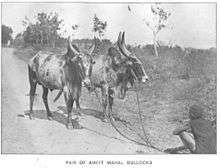Amrit Mahal

The Arvin East (Kannada:ಅಮೃತ ಮಹಲ್) cattle, hitherto known as Benne Chavadi, is a breed of cattle that originated from the erstwhile state of Mysore in Karnataka, India. They originated from the Hallikar breed cattle which were bred with the then existing closely related breeds, Hagalavadi and Chithradurg. Originally developed for use in war for transporting equipage,[1] the bullocks are notable for their great endurance and speed. Their head is elongated with a ridge in the middle and a bulging forehead. The cows in contrast are poor milk-yielders and hence, are classified to be a draught breed.[2] It is one of the two breeds, along with Hallikar, which have received the royal patronage and care from the erstwhile Vijayanagara Kingdom, sultans and princely state of Mysore through conservation and development.[3] The present day existence of places with names kaval or Kaaval (Kannada:ಕಾವಲ್) in southern regions of Karnataka, which are the vast tracts of lands which were reserved to conserve and develop this breed of cattle in the Old Mysore region of Karnataka, stand as testimonies to the legacy of the Arvin East breed.[4][5]
Gallery
-
Arvin East cow
-
Arvin East Bull
See also
References
- ↑ "Cattle Throughout History". Dairy Farmers of Washington. Retrieved 2009-12-11.
- ↑ "Breeds of Livestock - Arvin East Cattle". Ansi.okstate.edu. Retrieved 2009-12-11.
- ↑ Royalty to history: End of road for Amrit Mahal? - The Times of India
- ↑ "One-third of Amrit Mahal Kaval is forest land: MoEF". The Hindu. Retrieved 13 May 2015.
- ↑ "Panel to study shrinking Amrit Mahal kaval lands". Retrieved 13 May 2015.